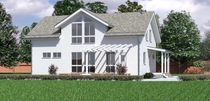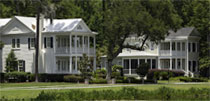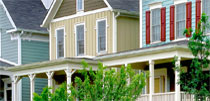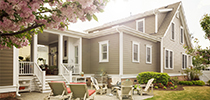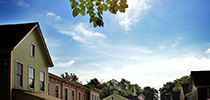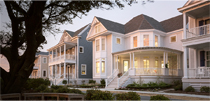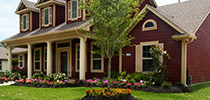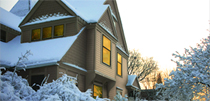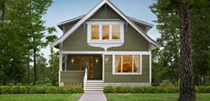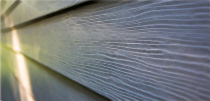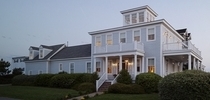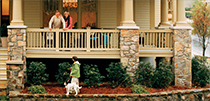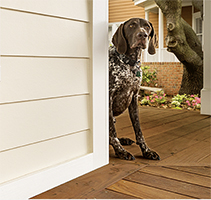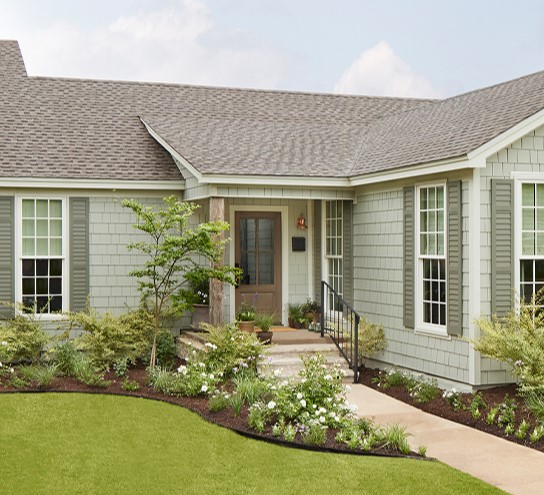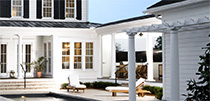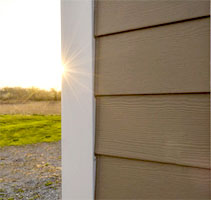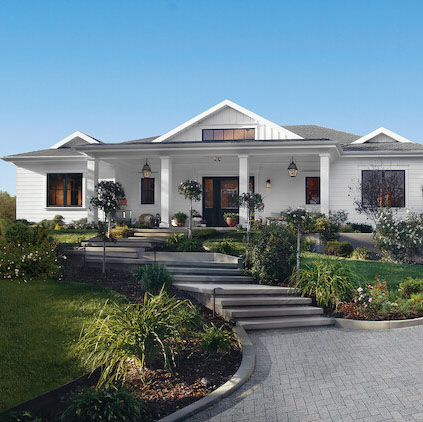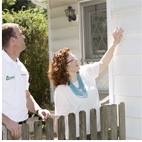by Lindsay Frankel
5/12/2023

Whether you’re building or remodeling, choosing new siding is an opportunity to wrap your home in a color that resonates with you. It’s important to think about curb appeal and resale value, but you can also express your individual style through your choices.
Just remember that when you choose a siding color, you’re in it for the long haul, according to design expert Beth R. Martin. “Since Hardie® products will last many years, you'll want to make a decision that feels timeless, not trendy" she says.
That may be why one of the most popular house siding colors in the nation is Arctic White. This clean and cool hue has a fresh feel that will appeal to anyone’s taste, even as color trends come and go. It also works well with contrasting dark trim and pops of bold accent color. Several other neutral tones are also popular with homeowners, and these vary by region. For inspiration, we asked experts how to utilize the most popular colors in each area, so you can start visualizing the look you want for your home.
The Most Popular Exterior House Colors by Region
Midwest

- - Iron Gray (pictured)
- - Cobble Stone
- - Aged Pewter
Bold Midwesterners may prefer the standout Iron Gray, which is deep and dramatic yet inviting, while homeowners who want a warmer, more versatile color may opt for Aged Pewter. Cobble Stone, which is in the taupe family of hues, contrasts well with rich green landscaping and darker accents.
Jeff Akerman, licensed architect and Strategic Construction Advisor at Real Estate Bees, says these colors work well with architectural styles common in the Midwest, such as Colonial or Craftsman style homes. But he advises homeowners not to be afraid of playing with accent colors. “While neutrals are popular for their versatility and timelessness, pops of bold color can be used effectively to add personality and character to a home.”
For example, you might complement Iron Gray with white or black shutters or trim, or even a show-stopping red door.
Northeast

- - Cobble Stone
- - Pearl Gray
- - Light Mist (pictured)
In the Northeast, where the landscape is lush with greenery, homeowners turn to lighter neutrals. In addition to Cobble Stone, Pearl Gray is popular for its understated softness, while Light Mist brings a touch of blue, like a brightening sky just after a gray Northeastern rain.
“Cape Cod, Colonial, and Victorian-style are prevalent in the country's Northeastern region,” says Martin. “These popular styles typically use lighter shades of natural grays, taupes, and whites, making this sophisticated neutral palette common throughout the region.”
If you’re looking to add accent colors, Akerman says neutrals like Cobble Stone and Light Mist work well with earth tones like brown, beige, and green, which can reflect the natural setting to provide seamlessness between your house and the outdoors.
South

- - Cobble Stone (pictured)
- - Pearl Gray
- - Light Mist
“You will also find a light, neutral color scheme in the South because of popular styles like the Modern Farmhouse and Greek Revival,” says Martin, but she notes that more saturated colors can also be common in Craftsman Bungalow styles and homes situated along the coast.
Southern homeowners can pair these popular neutrals with bolder hues in the same family. For example, “Pairing Light Mist with a stark white like Arctic White will enhance this lovely hue's crisp and cool undertones,” says Martin. “Highlights of moody dark blues like Blue Ribbon or Blue Shadow will make your accents pop.”
South Central

- - Cobble Stone
- - Iron Gray
- - Pearl Gray (pictured)
Neutral colors are popular in the South Central (Texas, Oklahoma, Arkansas) region as well, and whether you choose a soft backdrop like Pearl Gray or Cobble Stone, or a deeper hue like Iron Gray, you can play with earth tones to provide contrast. The golden, green, and brown tones of the plains provide plenty of inspiration for siding house colors in the area.
“The South Central region's bright sun brings Mediterranean-inspired architecture that uses golden, terra-cotta, and earthy tones,” says Martin. “You will also find a mix of updated Ranch homes and Contemporary mod homes that look striking in the landscape, using deep dark grays and vivid whites offset by earthy hues.”
West

- - Iron Gray
- - Cobble Stone
- - Evening Blue (pictured)
Unique to the West is Evening Blue, a striking hue in the navy family reminiscent of looking out over the ocean at dusk. Akerman says you can pair this bold yet soothing color with lighter shades of blue, gray, and white. Martin suggests hues like Bar Harbor Blue or Polaris White, specifically.
These color combinations work well for a board-and-batten beach house or expansive ranch style home, while more modern architectural styles may be better suited to neutrals like Iron Gray and Cobble Stone. Martin says you can pair Cobble Stone with the olive-toned Mudflats or opt for Almost Black accents if you want a more modern look.
Canada

- - Iron Gray
- - Cobble Stone
- - Aged Pewter (pictured)
Akerman says French Country and Colonial style homes in Canada work well with popular siding color choices in the area. One unique option is Aged Pewter, a warmer gray tone that strikes a balance between comfort and elegance and plays well with both lighter and darker accents. “It would look best paired with a light but creamy white like Birch Tree or Gauze White,” suggests Martin. “For a significant impact, you could also accent this with a darker contrast, like Black Water.”
How to Choose a Siding Color
-
Reflect on your home’s architectural style and surroundings: Akerman says a neutral siding color can “serve as a backdrop for other design elements, like landscaping or architectural details.” Consider the style of your home and narrow down your options to colors that would complement the architecture. Then, think about reflecting or contrasting the colors of the natural landscape in your area. You might also look to other homes in the area for inspiration, or check out our inspiration guide.
-
Choose a practical color that comforts you: Choose a color that you’ll want to come home to every day, one that sets your soul at ease. But don’t forget to consider what’s practical for your environment. “Hardie® products hold up incredibly well to the elements, but if your home is in an area with extreme direct sunlight, it's always a more low-maintenance option to select a lighter color,” says Martin. “A light color shows less wear over time, giving you more life out of your siding.”
-
Select your accent colors: Once you’ve selected a hue that resonates with you, it’s time to have a little fun with your color palette. “Don't be afraid to show your personality anywhere that can be repainted easily,” says Martin. “Your front door, shutters, porch ceiling, and even window trim are fun places to add color without worrying about the long-term commitment.”
-
Consider playing with texture: You may want to use a couple of different siding styles to add texture and visual appeal. For example, “Using vertical siding with a complementary color as an accent on the front of the house can create an interesting texture,” says Akerman. “Additionally, using different textures like shingles, panels, or trim can create a unique look.” Martin says you’ll have plenty of options if you choose Hardie® siding. “Besides its durability, the best thing about Hardie® products is the wide variety of available textures.” Check out our house siding gallery for ideas, or use our visualizer to see different colors and textures in action.
How to Achieve Long-Lasting Color
Lasting color starts with choosing a durable siding product designed to withstand the elements, and there’s no question that Hardie® fiber cement siding is the optimal choice. “James Hardie siding is particularly suited to long-lasting color because it uses ColorPlus® Technology, which bakes multiple coats of paint onto the siding for a durable and long-lasting finish,” says Akerman.
James Hardie’s proprietary finish is applied in a controlled environment to avoid disruption from debris and then cured between coats to strengthen the color’s adhesion. The end result is as beautiful as it is durable, resisting chipping, peeling, and cracking.
Proper maintenance will still be essential to maintaining the color of your exterior siding, however. Martin recommends washing your home’s exterior every six to 12 months to prevent mildew and other debris from building up on the surface. “Since Hardie® products are so durable and the color is actually baked onto the surface, it's only necessary to spray off your siding with a hose or power wash with very minimal pressure,” she says.
A little bit of care goes a long way when you have low maintenance Hardie® siding paired with a 30-year limited siding warranty and a 15-year limited ColorPlus® Technology finish warranty. Whether you grow old in your home or sell to an excited homebuyer in awe of your exterior design, you can rest easy knowing your siding color will endure the test of time.
*Most popular colors decided by 2022 Hardie® siding with ColorPlus® technology sales figures

